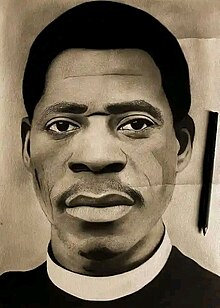Joseph Ayo Babalola
Joseph Ayo Babalola | |
|---|---|
 | |
| Born | 25 April 1904 Odo-Owa, Oke-Ero, Southern Nigeria Protectorate (now Kwara State, Nigeria) |
| Died | 26 July 1959 (aged 55) |
| Resting place | Grave Prayer House Mausoleum Effon-Alaiye, Ekiti State, Nigeria |
| Nationality | Nigerian |
| Citizenship | Nigerian |
| Occupation(s) | Apostle, Preacher |
| Title | Apostle Prophet |
| Partner | Dorcas Babalola |
| Children | Apeke Adeniyi |
Joseph Ayo Babalola (25 April 1904 – 26 July 1959) was a Nigerian Christian minister and the leader of the Christ Apostolic Church,[1] popularly called CAC in Nigeria. He was a healing evangelist.
Early life
[edit]Babalola was born of Yoruba parents at Odo-Owa, in Kwara State[2] and brought up as an Anglican. He attended elementary school at Oto-Awori on Badagry Road, Lagos State, in 1914.[2] He then became a steamroller operator under the PWD (Public Works Department), then under the control of Great Britain. He worked as a steamroller.[3][4]
Ministry and healing
[edit]In 1931, Faith Tabernacle affiliated with The Apostolic Church with general headquarters in the United Kingdom (not British Apostolic Church, as erroneously stated by some authors).[5] Following a schism in The Apostolic Church around 1940, Babalola went with a group led by Pastors J.B. Akinyele and D.O. Odubanjo to form an independent church,[6] Christ Apostolic Church (CAC), where he continued his healing and evangelism until his death.
The CAC regards Babalola as an apostle, although he was not ordained into that office. A CAC retreat center was built at Ipo Arakeji, Osun State where Babalola was called in 1928. However, Babalola was not the sole founder of CAC as many claim, but one of three founders.[7]
The Christ Apostolic Church outlived Babalola and grew rapidly, with many churches under the CAC name. Each church has a specific branch name. Joseph Ayo Babalola University (JABU) a private Nigerian university is located in Ipo Arakeji and Ikeji-Arakeji. Two neighbouring communities in Osun State, established by the Christ Apostolic Church Worldwide are named after him, located where he claimed he was called by God in 1928. [citation needed]
Death and documentary film
[edit]He died in 1959 and was buried in Efon Alaaye town in Ekiti state. Baba Abiye at Ede was, however, credited with the story of his death.[8]
A documentary film about Joseph Ayo Babalola was released by the Ogongo TV on Saturday, January 19, 2019.[9] The movie titled "Ayipada Nla", directed by Adeoye Omoniyi and produced by Adewale Omoniyi narrates how the late Babalola started his ministry in a Yoruba village from where the revival spread to other parts of Nigeria in 1930.[9]
See also
[edit]References
[edit]- ^ "Joseph Ayo Babalola: 60 years after". Tribune Online. 17 July 2019. Retrieved 8 March 2022.
- ^ a b "Short History of Christ Apostolic Church". joafosco.blogspot.com. 11 September 2009. Retrieved 6 May 2014.
- ^ Abi Olowe; Great Revivals, Great Revivalist - Joseph Ayo Babalola Archived 2009-01-30 at the Wayback Machine, Omega Publishers, 2007
- ^ "Special Feature on Heroes of Faith". memikoroduroad.org. Retrieved 6 May 2014.
- ^ S.A. Fatokun (2006), [http://www.oritajournal.org "The Apostolic Church Nigeria: The 'Metamorphosis' of an Indigenous-Prophetic Healing Movement into a Classical Pentecostal Denomination" in Orita – Ibadan Journal of Religious Studies, Vol. 38, June & Dec., pp. 49-70.
- ^ S.A. Fatokun (2005), "Pentecostalism in Nigeria with Particular Emphasis on The Apostolic Church in Southwestern Nigeria", PhD Thesis, Department of Religious Studies, University of Ibadan, Nigeria
- ^ S.E.A. Oludare (1999), "The Trio of CAC Founding Fathers", M.A. Dissertation, Department of Religious Studies, University of Ibadan, Nigeria.
- ^ Olajire, Bolarinwa. "HOW APOSTLE JOSEPH AYO BABALOLA DIED ON 26 JULY 1959". ServantBoy.com. Archived from the original on 28 May 2023. Retrieved 17 May 2024.
- ^ a b Oluwafemi Dosu. "Ayipada Nla movie, a story of Apostle Ayo Babalola released on Ogongo TV". GospelFilmNews.com. Archived from the original on 3 December 2023. Retrieved 26 May 2024.
Further reading
[edit]- Abi Olowe; Joseph Ayo Babalola Miracle Center Archived 30 January 2009 at the Wayback Machine, Omega Publishers, 2007
- Toyin Falola. The History of Nigeria, Greenwood Press, 1999
- Ogedegbe, I. O. "How Apostle Joseph Ayo Babalola dies". CAC World News. Archived from the original on 16 October 2022. Retrieved 27 May 2024.
- "Ayo Babalola". LitCaf. Archived from the original on 16 November 2024. Retrieved 20 November 2024.
